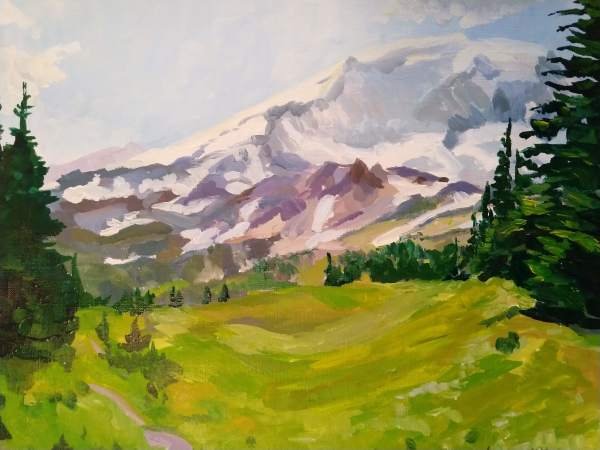Atmospheric perspective is how to create the illusion of depth that occurs in real life when the air particles make objects that are further away seem more blue and lighter in value. Using atmospheric perspective is a great way to create depth, add weather, and make a landscape feel more realistic.
What does Atmospheric Perspective Look Like?
When you see the far away mountains look lighter and bluer, that is atmospheric perspective in action. I always think of the Smoky Mountains National Park (see the above photo). Each mountain ridge gets a bit lighter as it heads up towards the horizon. The reverse is true, anything closer to the view needs to be more saturated in color and have more contrast.
Why does Atmospheric Perspective Happen?
A tiny bit of super non-scary science here. Atmospheric perspective happens because there is air between us and the mountain. The further away – the more air. That air is slightly occupied by dust, or moisture. And these particles reflect the light. This causes the light to shift a bit to the blue side, and to cover up the darks and the details (it gets fuzzy). The more the light bounces around the lighter it gets (it is like more light is shinning there).
On a foggy day there is a ton of water in the air. The result is that the hills can even disappear and merge with the sky or be a faint value difference. A smoky day does the same thing, but the particles cause the color to shift more orange, pink, brown in color, and the mountains are gobbled up by the sky more quickly.
How to Paint Atmospheric Perspective
After mixing the color of the mountains that are closest to you, add in a touch of titanium white and a blue (whatever blue you are using on your palette already). For each ridge of mountains further on, add more white and more blue.
Remember, it is about how much air there is between the viewers eyes and that object. The values will not always be consistently stepped up, but they need to be constantly stepped up. Which means if the next ridge is really close, it won’t have a lot of change! But, if it is farther away it needs to be lighter, or the viewer will feel like something is wrong.
Go ahead and play with it. Just a couple of colors and small square of paper and you can practice this technique. Creating a tall mountain that is a lot lighter is a great way to add height! See the painting below – the mountain feels very tall because the color is desaturated.
See related posts:
Creating Distance in Landscape Painting
Painting Tips: How to Paint Fog and Mist


